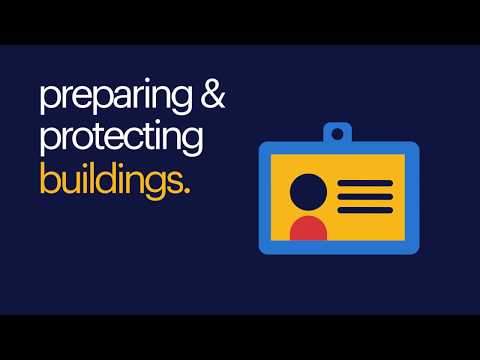operating an FM business during COVID-19 pandemic.
As the world looks to find new ways of working, both remotely and in offices, many will be asking how do we return to work safely and can we adapt to the Coronavirus pandemic?
The government's advice is frequently changing and adapting itself to the latest updates on the COVID-19 situation. We aim to stay up-to-date with their advice and inform you, our clients, the best practises to stay safe at work.
Read on to understand, in detail, our top tips to keep your workers safe in FM roles as we return to work. This includes our short animation to run over some easy steps to take that we will elaborate on in this article.
preparing and protecting buildings in a viral pandemic.
To ensure the health and hygiene of a building is protective enough for employees we need to ensure the following factors are considered.
- Raise office humidity above 40%, maintain warm temperatures and clean thoroughly.
- Plan future schedules for closed and partially open buildings.
- Screen visitors before entry - temperature checks.
- Restrict visitors to essential only.
Generally, viruses love to thrive in dry cold conditions. Office buildings of recirculated air from air-con units that maintain a dehumidifying setting with temperatures below 20oC are common and a factor in employee sickness. Well-ventilated offices will often see a reduction in employee health issues.
By raising the humidity in an office to 40% - 60% and establishing temperatures to at least above 20oC it allows the body to naturally be in its most protective state for healthy cells to regenerate and fight off infections. With COVID-19 the biggest threat right now labelled as a virus, this is not a cure but the best preventative measure we can easily control in an office environment to give employees the best fighting chance. With this comes a paramount focus on thorough cleaning of all surfaces at regular intervals.
Secondary to climate control and cleaning is maintaining interactions with others. Simple measures to control the numbers of people in one location and ensuring those that are working are healthy with no signs of potential risk allows better prevention of infection. By planning across multiple locations opening times and restricted openings you are better suited to control potential risk to Coronavirus.
protecting workers onsite and online.
Security is a big factor to consider during a pandemic for both unmanned locations and supporting those working from home without the usual digital infrastructure they are used to. Our top points to consider are:
- Assess video monitoring and access points.
- Automate entry doors with sensors / manned-locks.
- Keep visitor logbooks and ensure staff have updated contact details.
- Adapt technology usage and provide necessary access off-site.
A key focus during a pandemic is monitoring software and hardware. With locations left unattended, there is a greater risk of break-ins or unauthorised access. Cameras and surveillance systems need to be checked for operational capacity and transference to potential cloud sharing online for remote access. Monitoring from an off-site location presents the potential for a greater overview and reduced labour time for individual sites. Here-in also presents the problems in setting up, if it doesn't already exist, an online framework for sharing multiple cameras to secure locations with access for specified personnel within the business. This requires time to plan and assess the best method to have total surveillance and control over sites.
Reducing touch across the business will also factor in the level of security of a building and location. If doors can be automatically opened by non-touch security systems they should. If not can access points be controlled off-site or onsite by manned locks for authorised entry? In order to achieve this software may need to be rolled out to workers off-site to control systems or the central server upgraded for remote access.
Finally, the simple method of logging entry and exit traffic of visitors to locations will help for easy tracking of potential risks of spreading COVID-19. Then you will need to ensure all the contact details of staff are all up-to-date so they can be contacted easily both for everyday working and if they are suspect of risk to Coronavirus.
maintaining facilities and equipment.
To support the return to work, the new workplace will need to be adapted to suit the current demands of the government's lockdown guidance and safety protocol to avoid COVID-19 infection. The heart of the working environment are the facilities and equipment used to secure and maintain them. The following key points cover these concerns.
- Maintain air-con to 40% - 60% humidity (viruses thrive in low humidity).
- Check recirculation filters are fit for purpose or replace with extraction units.
- Maintain fire safety regulations adapted for social distancing.
- Adjust units for lowered capacity buildings.
- Fire safety operatives are classed as ‘key workers’.
As previously discussed the HVAC systems within a building or basic air filtration units need to be assessed for their ability to handle viral outbreak. Are the filters appropriate and has the system been checked within regulations? These regulations may change and will need to re-checked so someone will need to be able to conduct that check.
The standard operational factors in fire safety and entry / exit routes will need to be looked at again to ensure social distancing can be enforced throughout the process.
It is also important to note that as the government's guidance changes more workers may be classed as key workers so staff will need to be updated to their requirements for work. Currently, fire safety jobs are included in this and will be required to ensure the ongoing stability of businesses.
communication is key.
All workers must be informed of the latest updates to their requirements for work. Whether they are on furlough or working from home or you are looking for new staff, the guidance decided for your location will need to be relayed to them quickly and efficiently. Our top tips for communication are as follows.
- Clear, consistent and regular communication.
- Check for accurate emails, numbers and locations.
- Listen to feedback and adapt to a new schedule.
Communication is a two-way street, you need to hear from your employees as well as tell them what they need to be doing to stay safe. If workers are concerned about their health or at classed as at risk what can you do to support them? Think of all aspects to physical, psychological and financial support and how you can help ensure a happy workforce in these trying times.
You will also need to be able to contact them, so a general check of addresses, phone numbers and emails is important now to ensure communication is not lost.
For the latest up to date information please consult the governments guidelines.
To get in touch to discuss how we can help you, find your local branch here.




